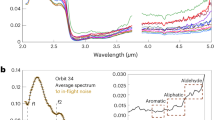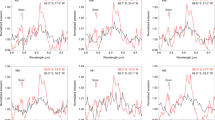Abstract
Hyperion, Saturn’s eighth largest icy satellite, is a body of irregular shape in a state of chaotic rotation1,2. The surface is segregated into two distinct units. A spatially dominant high-albedo unit having the strong signature of H2O ice contrasts with a unit that is about a factor of four lower in albedo and is found mostly in the bottoms of cup-like craters. Here we report observations of Hyperion’s surface in the ultraviolet and near-infrared spectral regions with two optical remote sensing instruments on the Cassini spacecraft at closest approach during a fly-by on 25–26 September 2005. The close fly-by afforded us the opportunity to obtain separate reflectance spectra of the high- and low-albedo surface components. The low-albedo material has spectral similarities and compositional signatures that link it with the surface of Phoebe and a hemisphere-wide superficial coating on Iapetus.



Similar content being viewed by others
References
Wisdom, J., Peale, S. J. & Mignard, F. The chaotic rotation of Hyperion. Icarus 58, 137–152 (1984)
Thomas, P. & Veverka, J. Hyperion — Analysis of Voyager observations. Icarus 65, 414–424 (1985)
Hendrix, A. R. & Hansen, C. J. Ultraviolet observations of Phoebe from Cassini UVIS. Icarus (in the press)
Cruikshank, D. P. & Brown, R. H. Surface composition and radius of Hyperion. Icarus 50, 82–87 (1982)
Clark, R. N. et al. Compositional mapping of Saturn’s moon Phoebe with imaging spectroscopy. Nature 435, 66–69 (2005)
Buratti, B. J. et al. Cassini visual and infrared mapping spectrometer observations of Iapetus: Detection of CO2 . Astrophys. J. 622, L149–L152 (2005)
Sandford, S. A. & Allamandola, L. J. The physical and infrared spectral properties of CO2 in astrophysical ice analogs. Astrophys. J. 355, 357–372 (1990)
McCord, T. B. et al. Non water-ice constituents in the surface material of the icy Galilean satellites from the Galileo near-infrared mapping spectrometer investigation. J. Geophys. Res. 103, 8603–8626 (1998)
Hibbitts, C. A. & Szanyi, J. Physisorption of CO2 on non-ice materials of relevance to icy satellites. Lunar. Planet. Sci. Conf. XXXVII, 1753 (2006)
Chaban, G. M., Bernstein, M. & Cruikshank, D. P. Carbon dioxide on planetary bodies: Theoretical and experimental studies of molecular complexes. Icarus 187, 592–599 (2007)
Lebofsky, L. A. Stability of frosts in the solar system. Icarus 25, 205–217 (1975)
Cruikshank, D. P. et al. Hydrocarbons on Saturn’s satellites Iapetus and Phoebe. Icarus (in the press)
Brown, R. H. et al. Composition and physical properties of Enceladus’ surface. Science 311, 1425–1428 (2006)
Bernstein, M. P. et al. UV irradiation of polycyclic aromatic hydrocarbons in ices: Production of alcohols, quinones, and ethers. Science 283, 1135–1138 (1999)
McDonald, G. D., Thompson, W. R., Heinrich, M., Khare, B. N. & Sagan, C. Chemical investigation of Titan and Trion tholins. Icarus 108, 137–145 (1994)
Khare, B. N. et al. Optical constants of organic tholins produced in a simulated Titanian atmosphere — From soft X-ray to microwave frequencies. Icarus 60, 127–137 (1984)
Jarvis, K. S., Vilas, F., Larson, S. M. & Gaffey, M. J. Are Hyperion and Phoebe linked to Iapetus? Icarus 146, 125–132 (2000)
Buratti, B. J., Hicks, M. D., Tryka, K. A., Sittig, M. S. & Newburn, R. L. High-resolution 0.33–0.92 μm spectra of Iapetus, Hyperion, Phoebe, Rhea, Dione, and D-type asteroids: How are they related? Icarus 155, 375–381 (2002)
Acknowledgements
We thank the many people in the Cassini Project whose skills and diligence have made the mission to Saturn a success. The Cassini Project is managed by the Jet Propulsion Laboratory.
Author information
Authors and Affiliations
Corresponding author
Ethics declarations
Competing interests
Reprints and permissions information is available at www.nature.com/reprints. The authors declare no competing financial interests.
Supplementary information
Supplementary Information
This file contains Supplementary Notes, Supplementary Figure 1 and additional references. (PDF 579 kb)
Rights and permissions
About this article
Cite this article
Cruikshank, D., Dalton, J., Ore, C. et al. Surface composition of Hyperion. Nature 448, 54–56 (2007). https://doi.org/10.1038/nature05948
Received:
Accepted:
Issue Date:
DOI: https://doi.org/10.1038/nature05948
- Springer Nature Limited
This article is cited by
-
Water and Volatiles in the Outer Solar System
Space Science Reviews (2017)
-
Constraints from Comets on the Formation and Volatile Acquisition of the Planets and Satellites
Space Science Reviews (2015)
-
Characteristics of Icy Surfaces
Space Science Reviews (2010)
-
Spectroscopy of Icy Moon Surface Materials
Space Science Reviews (2010)
-
Chemical Composition of Icy Satellite Surfaces
Space Science Reviews (2010)





